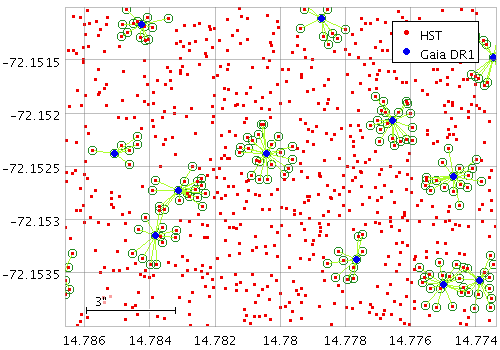
mark2
Plots 2 similar markers of fixed size and shape representing 2 separate positions from the same input table row. This is a convenience option that can be used with other plot layers based on 2 positions.
Usage Overview:
layerN=mark2 shapeN=filled_circle|open_circle|... sizeN=<pixels>
shadingN=auto|flat|translucent|transparent|density|aux|weighted|paux|pweighted <shade-paramsN>
<pos-coord-params1N> <pos-coord-params2N> inN=<table>
ifmtN=<in-format> istreamN=true|false icmdN=<cmds>
All the parameters listed here
affect only the relevant layer,
identified by the suffix
N.
<pos-coord-params1N>
, <pos-coord-params2N>
give 2 positions for each row of the input table.
Their form depends on the plot geometry,
i.e. which plotting command is used.
For a plane plot (plot2plane)
the parameters would be
x1N, y1N,
x2N and y2N.
The coordinate parameter values are in all cases strings
interpreted as numeric expressions based on column names.
These can be column names, fixed values or algebraic
expressions as described in Section 10.
Example:

stilts plot2sky clon=14.78 clat=-72.1525 radius=0.0015 sex=false
layer_h=mark in_h=ngc346.fits lon_h=_RAJ2000 lat_h=_DEJ2000 color_h=red
layer_g=mark in_g=ngc346xGaiadr1.fits lon_g=ra lat_g=dec color_g=blue shading_g=flat size_g=3
in_x=ngc346xGaiadr1.fits lon1_x=_RAJ2000 lat1_x=_DEJ2000 lon2_x=ra lat2_x=dec shading_x=flat
layer_xl=link2 color_xl=greenyellow
layer_xm=mark2 color_xm=forestgreen size_xm=4 shape_xm=open_circle
seq=_xm,_xl,_h,_g leglabel_h=HST leglabel_g='Gaia DR1' legseq=_h,_g legpos=0.95,0.95
icmdN = <cmds> (ProcessingStep[])
inN.
The value of this parameter is one or more of the filter
commands described in Section 6.1.
If more than one is given, they must be separated by
semicolon characters (";").
This parameter can be repeated multiple times on the same
command line to build up a list of processing steps.
The sequence of commands given in this way
defines the processing pipeline which is performed on the table.
Commands may alternatively be supplied in an external file,
by using the indirection character '@'.
Thus a value of "@filename"
causes the file filename to be read for a list
of filter commands to execute. The commands in the file
may be separated by newline characters and/or semicolons,
and lines which are blank or which start with a
'#' character are ignored.
A backslash character '\' at the end of a line
joins it with the following line.
ifmtN = <in-format> (String)
inN.
The known formats are listed in Section 5.1.1.
This flag can be used if you know what format your
table is in.
If it has the special value
(auto) (the default),
then an attempt will be
made to detect the format of the table automatically.
This cannot always be done correctly however, in which case
the program will exit with an error explaining which
formats were attempted.
This parameter is ignored for scheme-specified tables.
[Default: (auto)]
inN = <table> (StarTable)
-",
meaning standard input.
In this case the input format must be given explicitly
using the ifmtN
parameter.
Note that not all formats can be streamed in this way.:<scheme-name>:<scheme-args>.<" character at the start,
or a "|" character at the end
("<syscmd" or
"syscmd|").
This executes the given pipeline and reads from its
standard output.
This will probably only work on unix-like systems.istreamN = true|false (Boolean)
inN parameter
will be read as a stream.
It is necessary to give the
ifmtN parameter
in this case.
Depending on the required operations and processing mode,
this may cause the read to fail (sometimes it is necessary
to read the table more than once).
It is not normally necessary to set this flag;
in most cases the data will be streamed automatically
if that is the best thing to do.
However it can sometimes result in less resource usage when
processing large files in certain formats (such as VOTable).
This parameter is ignored for scheme-specified tables.
[Default: false]
shadingN = auto|flat|translucent|transparent|density|aux|weighted|paux|pweighted <shade-paramsN> (ShapeMode)
[Default: auto]
shapeN = filled_circle|open_circle|... (MarkerShape)
The available options are:
filled_circle
open_circle
cross
x
open_square
open_diamond
open_triangle_up
open_triangle_down
fat_circle
fat_cross
fat_x
fat_square
fat_diamond
fat_triangle_up
fat_triangle_down
filled_square
filled_diamond
filled_triangle_up
filled_triangle_down
[Default: filled_circle]
sizeN = <pixels> (Integer)
[Default: 1]